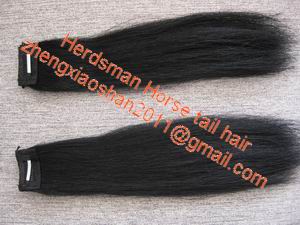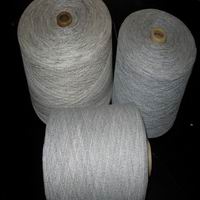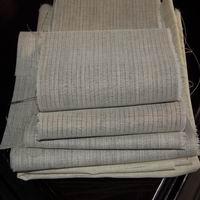creating variations of pattern horse hairsHuman hair tends t
Horse hair pottery has come to a lot of potters attention over the recent past. This technique does indeed use hairs from horses (some other animal hair has also been used, with mixed results). Basically, the idea is to burn the hairs on the pots suce to create lines. As hair is laid upon glowing hot pots straight form the kiln, horse hairs they sear onto the pots suce and will leave very localized carbon markings.

The pottery piece is formed, then burnished. Burnished pottery works best, as the smooth unglazed suce accepts the carbon marking with the strongest effect.
The piece is fired to between 1300F and 1800F in a raku kiln. Using the raku kiln allows much easier access to the ware.
Once temperature is reached, the incandescent pottery is taken from the kiln using long raku tongs and proper gauntlets and other protective gear. The hot pottery is place on a non-flammable suce (such as a piece of broken kiln shelf) and the selected hairs are draped onto it.
Once the piece has cooled completely, it is washed to remove residue. It can then be waxed to bring out the markings.
Horse hair pottery requires a porous ceramic body in order for the carbon to permanently mark the suce. Due to this, the best clay bodies to use are also the same as are best for raku. Such clay bodies should contain at least 15% grog, and may include up to 40% grog. Such a clay body is often rough and almost impossible to burnish if left as is. In order to get that lovely smooth, buttery burnished suce, first cover the piece with terra sigillata. Another aspect to note is that horse hair pottery should never be considered functional ware. It is not food-safe and is also liquid permeable. (In other words, it cannot be used as a fresh-flower vase, either, unless it is fired high enough for raku glazes to be used on the interior.)
As one would expect, the main material used to create this type of pottery is horse hair. However, that is not the final word.
Horse tail hairs produce thicker, stronger lines on the pottery, as they are coarser than mane hairs.
Feathers and long, coarse dog hair have also been used, creating variatcreating variations of pattern horse hairsHuman hair tends to be much too fine,ions of pattern. horse hairsHuman hair tends to be much too fine; however,Horse hair braids for, use of a braid of hair might be worth investigating.
Each pottery piece will generally use only ten to twelve horse hairs. Using more than this reduces the visual impact of the finished piece.
Image Courtesy of Katherine Blocksdorf, the Guide to Horses here at About.com.

Dont be afraid to experiment and put your own stamp on the horse hair pottery process. Variations can include
using raku glazes (ones that do not require overall reduction to look nice) in conjunction with the horse hair technique, horse hairs
using a high-speed rotary tool to lightly carve designs through the suce markings in areas. (This Kokopelli figurine has small designs etched into the skirt and eye areas.
查看相关产品:












